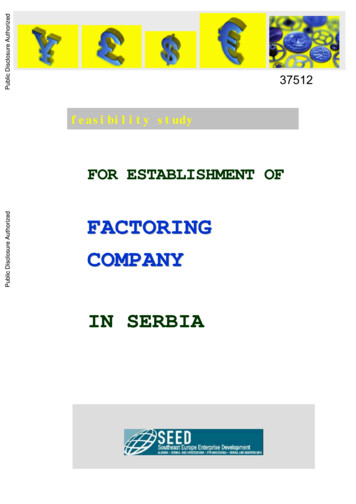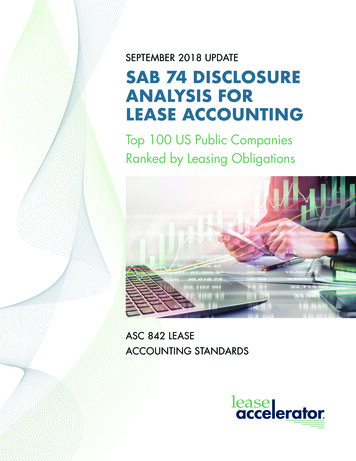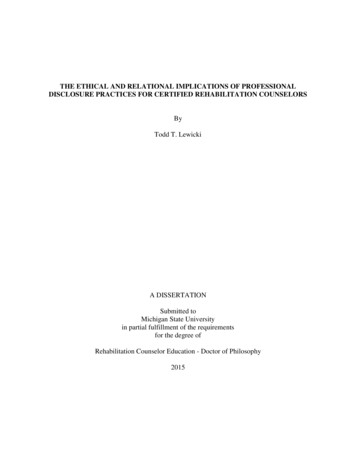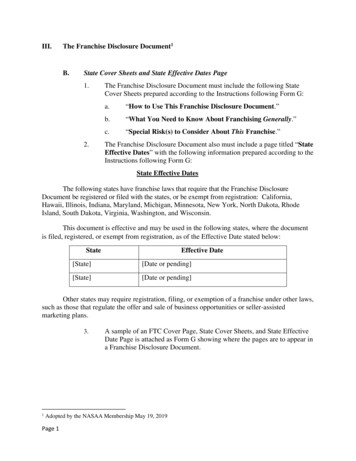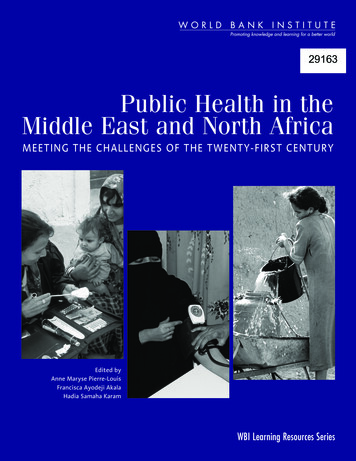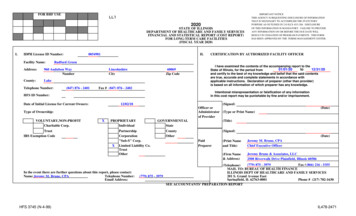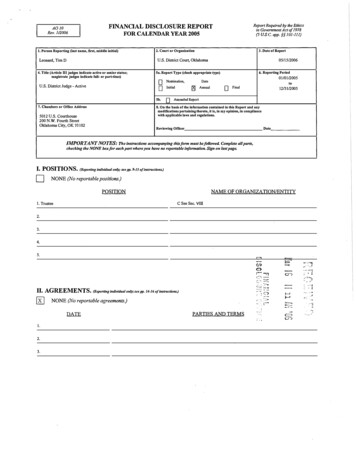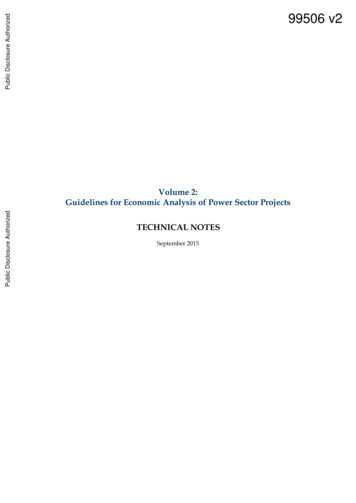
Transcription
2020Disclosure Report as at 31 Decemberin accordance with the Capital Requirements Regulation (CRR)The bank at your side
Contents3Introduction5Equity capital, capital requirement and RWA5913162269799699Risk-oriented overall bank managementRisk statement18Risk management organisation18Risk strategy and risk management20Risk-bearing capacity and stress testingA. Credit risk (CR)22Risk management25Credit risk model34Credit risk mitigation37Credit risk and credit risk mitigation in the IRBA43Credit risk and credit risk mitigation in the SACR46Overarching portfolio analyses52Loan loss provisions for default risks67Investments in the banking bookB. Counterparty credit risk (CCR)69Risk management71Information on regulatory methods73Information by regulatory risk-weighting approach77Further information on counterparty credit riskC. Securitisations (SEC)Risk management81Valuation methods and quantitative informationD. Market risk (MR)86Risk management88Market risk model90Quantitative information on market risks94Interest rate risk in the banking bookE. Liquidity risk (LR)96Risk management96Liquidity risk modelF. Operational risk (OR)99103Securitisation process80100102Connection between balance-sheet and regulatory positionsCapital requirements and RWA167986Capital structureRisk managementOpRisk modelG. Other risksAppendix103Additional tables (Appendix 1 to Appendix 5)119Overview: Compliance with the CRR requirements (Appendix 6)122List of abbreviationsDue to rounding, numbers and percentages presented throughout this report may not add up precisely to the totals provided.
IntroductionEquity capitalRisk-oriented overall bank managementSpecific risk nk is the leading bank for SMEs (the Mittelstand) andObjective of the Disclosure Reporta strong partner to some 30,000 corporate client groups andThis report is intended to give the reader a detailed insight intoaround 11 million private and small-business customers in Ger-Commerzbank’s current risk profile and risk management. In par-many. The Bank offers a comprehensive portfolio of financial ser-ticular, it contains information on:vices in two business segments – Private and Small-Business Cus- the Commerzbank Group’s structure from both a regulatorytomers and Corporate Clients.Commerzbank focuses on German SMEs, large companies andinstitutional customers. In international business, the Bank supports customers who have business links with Germany and companies in selected future-oriented sectors. Following the integra-and accounting perspective, the Group’s capital structure, the Commerzbank Group’s general risk management systemand the risk management in respect of specific types of risk.tion of comdirect, private and small-business customers benefitfrom the services of one of Germany’s most modern online banksThe report may also be seen as complementary to the Annualcombined with personal advisory services at a local level. TheReport pursuant to the German Commercial Code (Han-Polish subsidiary mBank is an innovative digital bank. It servesdelsgesetzbuch – HGB), since in contrast to the Annual Report itaround 5.7 million private and small-business customers, mainlyfocuses primarily on the supervisory perspective.in Poland but also in the Czech Republic and Slovakia.In this report Commerzbank Aktiengesellschaft as the ultimateThe two segments Private and Small-Business Customers andparent company of the regulated banking group is complying withCorporate Clients are each managed by a member of the Board ofthe disclosure requirements of Articles 431 – 455 of regulationManaging Directors. All staff and management functions are con-(EU) No. 575/2013 – the Capital Requirements Regulation (CRR)tained in Group Management: Group Audit, Group Communica-and the guidelines on the disclosure requirements under Parttions, Group Compliance, Group Finance, Group Human Re-Eight of Regulation (EU) No. 575/2013 - EBA/GL/2016/11 - as atsources, Group Investor Relations, Group Legal, Group Research,31 December 2019.Group Risk, Big Data & Advanced Analytics, Group Strategy Trans-The tables defined according to the EBA’s guidelines and inte-formation & Sustainability, Group Tax, Group Treasury and thegrated into the report are indicated by the table names providedcentral risk functions. The support functions are provided bywith the prefix EU.Group Services. These include Group Corporate Clients&TreasuryFulfilment of the CRR requirements within the CommerzbankPlatforms, Group Business Platform, Group Digital Transformation,Group is presented in detail in the „Overview: Compliance with theGroup Banking& Market Operations, Group Technology Founda-CRR requirements“ in the appendix (table APP6).tions, Group Operations Credit, Group Organisation&Security,Group Delivery Centre and Group Client Data. The staff, manage-Scopement and support functions are combined in the Others and Con-This Disclosure Report is based on the group of companies consol-solidation division for reporting purposes.idated for regulatory purposes. The companies consolidated forOn the domestic market, Commerzbank Aktiengesellschaft isregulatory purposes only include those carrying out banking andheadquartered in Frankfurt am Main, from where it manages itsother financial business. The consolidated group consists of a do-branch network serving all customer groups. Following the mer-mestic parent company and its affiliated companies. The aim ofger with comdirect Bank AG, Commerz Real AG is now the biggestregulatory consolidation is to prevent multiple use of capital thatdomestic subsidiary. Outside of Germany, Commerzbank has 6in fact exists only once by subsidiary companies in the financialmaterial subsidiaries, 20 operational foreign branches and 30 rep-sector. The companies consolidated under IFRS, by contrast,resentative offices in just under 50 countries and is represented incomprise all the companies controlled by the ultimate parentall major financial centers, such as London, New York, Tokyo andcompany.Singapore. However, the focus of the Bank’s international activities is on Europe.A detailed description of Commerzbank Group is given in theAnnual Report 2020.In the context of the disclosure requirements (Article 431 (3)CRR), besides the Disclosure Report itself, all policies and processes have to be documented as a main component to fulfil the Pillar 3requirements of the Basel framework. The appropriateness andpracticality of the Bank’s disclosure practice has to be reviewed ona regular basis. For this purpose, Commerzbank has defined guidelines for the Disclosure Report which regulate the overarching,3
4Commerzbank Disclosure Report 2020strategic part of the instructions. The operative targets and respon-the management body and can therefore exercise a dominant in-sibilities are additionally defined in separate documents.fluence over the subsidiary.2Commerzbank is one of the largest institutions in Germany andIn the case of institutions and parent companies that were al-with its consolidated balance sheet total it is regularly well aboveready making use of a waiver before the CRR came into effect un-the 30bn limit relevant for the annual disclosure. Hence, Com-der the rules of the German Banking Act (KWG) applicable at themerzbank has implemented the reporting requirements during thetime, using the disclosure procedure then specified, exemption isperiod from Q2 2015 on and discloses the quarterly and semi-deemed to have been granted under Article 7 CRR and the rele-annually required information as appropriate.1vant standards under section 25a (1) sentence 3 KWG (see section2a (5) KWG).Waiver rule pursuant to Article 7 CRRUntil the merger of comdirect Bank AG into Commerzbank Ak-Under the waiver rule pursuant to Article 7 CRR in conjunctiontiengesellschaft on 2 November 2020 was completed, the waiverwith section 2a (1) of the German Banking Act (KWG), subsidiarywas invoked by comdirect Bank AG. The supervisory authoritiescompanies in a banking group may apply for exemption from thewere informed upon notification of completion according to §10requirements of Article 6 (1) CRR (on capital, large exposures, ex-sentence 3 of the German law, that this claim became void withposures to transferred credit risk and disclosure) at single entitythe completion of the merger.level. This is on condition, among other things, that both the par-According to Article 7 CRR in conjunction with section 2a (1)ent company and subsidiary are licensed in the same memberKWG, parent companies within the group of companies consoli-state and the subsidiary is included in the supervision on a consol-dated for regulatory purposes are also entitled to this exemption.idated basis of the parent company.The opportunity this offers for Commerzbank Aktiengesellschaft asExemption is also on condition that there is no current or fore-the ultimate parent company of the Commerzbank Group to beseen material practical or legal impediment to the prompt transferexempted from the requirements at single entity level has beenof own funds or the repayment of liabilities by the parent company,utilised since 2007. The conditions for claiming the waiver contin-that the parent company guarantees the commitments entered intoue to apply.by the subsidiary, the risk evaluation, measurement and controlUtilisation of the waiver rule was reported at the outset to BaFinprocedures of the parent company cover the subsidiary, and theand the Bundesbank with evidence of compliance with the require-parent company holds more than 50% of the voting rights in thements and is subsequently monitored and documented on occasion.subsidiary or can appoint or remove a majority of the members of12See EBA/GL/2014/14, title V (18) and EBA/GL/2016/11 No. 46.Under Article 7 (1) d) CRR, a dominant influence means either having a majority of voting rights or having the right to appoint amajority of the members of the management body of the subsidiary.
IntroductionEquity capitalRisk-oriented overall bank managementSpecific risk managementAppendixEquity capital, capital requirement andrisk-weighted assetsCapital structureCommerzbank seeks to achieve the following objectives inmanaging its capital:The main rules governing compliance with minimum regulatorycapital ratios for solvency purposes in the EU are contained in the adherence to the statutory minimum capital requirements atCapital Requirements Directive (CRD) IV, the Capital Require-Group level and in all companies included in the regulatoryments Regulation (CRR), a European regulation which, unlike theCRD IV Directive, has direct legal effect for all European banks,together with the SSM Regulation (Council Regulation No.1024/2013 of 15 October 2013 conferring specific tasks on theEuropean Central Bank concerning policies relating to the prudential supervision of credit institutions). This legislation is supplemented at national level in Germany by further provisions in theGroup, ensuring that the planned capital ratios are met, including thenew ECB/EBA requirements, provision of sufficient reserves to guarantee the Bank’s freedom of action at all times, strategic allocation of Tier 1 capital to business segments anddivisions in order to exploit growth opportunities.German Banking Act, the German Solvency Regulation and otherregulations. In addition, Implementing Technical Standards (ITS)The financial crisis made the importance of adequate CET1and Regulatory Technical Standards (RTS) provide explanationscapital levels for banks become an issue of increasing public con-about particularly complex matters. The introduction of the newcern. At Commerzbank, Tier 1 capital has always been a key man-regulations in 2014 has strengthened the quality of regulatory cap-agement target. The Bank’s specifications for the capital ratios farital compared with the previous regime, made capital require-exceed the minimum statutory requirements. The Bank’s risk-ments more stringent and set higher minimum requirements forbearing capacity and market expectations play an important role inbanks’ capital adequacy.determining the internal capital ratio targets. For this reason,To avoid having all these requirements take effect on a singleCommerzbank has stipulated minimum ratios for regulatory capital.date, certain parts of the new rules which took effect in 2014 areCET1 capital is allocated via a regular process that takes ac-subject to defined phase-in rules (with transitional provisions). Thecount of the Bank’s strategic direction, profitable new businessPhasing-in of the rules for capital deductions ended at the begin-opportunities in the core business of each business segment asning of the 2018 financial year. The CRR Regulation published inwell as aspects of risk-bearing capacity.2013 now only contains transitional provisions for the AdditionalMeasures relating to the Bank’s capital are approved by the fullTier 1 capital and Tier 2 capital, which will gradually reduce theBoard of Managing Directors, subject to the authorisation grantedrecognition of non-CRR-compliant capital issues until 2022.by the annual general meeting. During the past year, Commerz-Common Equity Tier 1 (CET1) capital consists largely of sub-bank met the minimum statutory capital requirements as well asscribed capital plus reserves and non-controlling interests. Adjust-the requirements of the ECB and EBA at all times. In the pro formaments to this figure may be necessitated by any number of causes,calculation of the fully loaded implementation of the CRR require-for example goodwill, intangible assets, write-downs of assets (ifments, the above mentioned transitional regulations are complete-assets are not valued cautiously enough in the regulator’s view),ly disregarded.shortfalls due to the comparison of expected losses (EL) with theFor the Commerzbank Group, the transitional provisions laidprovisions recognised for them and the correction of tax loss carry-down in Article 468 CRR and Article 473a shall not apply. We haveforwards. Adding Additional Tier 1 capital (AT1), which can containreceived approval from the supervisor for the application of thesubordinated debt instruments with certain conditions, producestransitional regime to IFRS 9 in accordance with Article 473a CRR.Tier 1 capital. Tier 2 capital consists largely of subordinated debtHowever, the effects from the application are so marginal that weinstruments which are not eligible as Additional Tier 1 capital. Thedo not take these into account as of 31 December 2020.eligibility of these capital components has been reduced, as overthe final five years of their life they may now only be amortised on astraight-line basis.Information on equity capital, capital ratios and the leverage ratio reflect the full impact of the IFRS 9 introduction.5
6Commerzbank Disclosure Report 2020The evaluations in the tables below comprehensively illustratethe total own funds available for the entire Commerzbank Group.Article 437 (1) b) and c) CRR are given on the Commerzbank website in the section Debt holder information/Capital instruments.These own funds are also the basis for the calculation of the equitycapital adequacy as reported to the Bundesbank. Details of theThe composition of the regulatory capital and the capital ratiosare as follows:issued capital instruments of Commerzbank Group according toCAP1: Equity structure (basis: EU 1423/2013)Line mA: Amount on the dayof disclosureCommon Equity Tier 1 capital: instruments and reserves1Capital instruments and the related share premium accounts1athereof: subscribed capital1bthereof capital reserve2Retained earnings3Accumulated other comprehensive income (and other reserves, to include unrealised gains and lossesunder the applicable accounting standards)12,7361,25211,48415,483– 4883aFunds for general banking risk04Amount of qualifying items referred to in Art. 484 (3) and the related share premium accounts subject tophase out from CET105Minority interests (amount allowed in consolidated CET1)5aIndependently reviewed interim profits net of any foreseeable charge or dividend6Common Equity Tier 1 (CET1) capital before regulatory adjustments647028,378Common Equity Tier 1 (CET1) capital: regulatory adjustments7Additional value adjustments (negative amount)– 1898Intangible assets (net of related tax liability) (negative amount)– 45710Deferred tax assets subject to future profit ratio excluding those arising from temporary differences (netof related tax liability where the conditions in Art. 38 (3) are met) (negative amount)– 28811Fair value reserves related to gains or losses on cash flow hedges12Negative amounts resulting from the calculation of expected loss amounts13Any increase in equity that results from securitised assets (negative amount)14Cumulative gains and losses due to changes in own credit risk on fair valued liabilities15Defined benefit pension fund assets (negative amount)16Direct and indirect holdings by an institution of own CET1 instruments (negative amount)17Holdings of the CET1 instruments of financial sector entities where those entities have reciprocal crossholdings with the institution designed to inflate artificially the own funds of the institution (negativeamount)018Direct and indirect holdings by the institution of the CET1 instruments of financial sector entities wherethe institution does not have a significant investment in those entities (amount above 10% threshold andnet of eligible short positions) (negative amount)019Direct, indirect and synthetic holdings by the institution of the CET1 instruments of financial sectorentities where the institution has a significant investment in those entities (amount above 10% thresholdand net of eligible short positions) (negative amount)020aExposure amount of the following items which qualify for a RW of 1250%, where the institution opts forthe deduction alternative20bthereof: qualifying holdings outside the financial sector (negative amount)20cthereof: securitisation positions (negative amount)20dthereof: free deliveries (negative amount)21Deferred tax assets subject to future profit ratio and arising from temporary differences (amount above10% threshold, net of related tax liability where the conditions in Art. 38 (3) are met) (negative amount)– 42– 1480–1– 68–2– 1780– 1780– 344
IntroductionEquity capitalRisk-oriented overall bank managementSpecific risk managementLine m222325AppendixA: Amount on the dayof disclosureAmount exceeding the 15% threshold (negative amount)thereof: direct and indirect holdings by the institution of the CET1 instruments of financial sectorentities where the institution has a significant investment in those entitiesthereof: deferred tax assets subject to future profit ratio and arising from temporary differences00025aLosses for the current financial year (negative amount)– 2,96225bForeseeable tax charges relating to CET1 items (negative amount)027Qualifying AT1 deductions that exceed the AT1 capital of the institution (negative amount)027aOther CET1 capital elements or deductions28Total regulatory adjustments to Common Equity Tier 1 (CET1) capital– 4,76729CET1 capital23,611– 87Additional Tier 1 (AT1) capital: instruments30Capital instruments and the related share premium accounts31thereof: classified as equity under applicable accounting standards32thereof: classified as liabilities under applicable accounting standards2,6192,619033Amount of qualifying items referred to in Art. 484 (4) and the related share premium accounts subject tophase out from AT145234Qualifying Tier 1 capital included in consolidated AT1 capital (including minority interests not included inline 5) issued by subsidiaries and held by third parties1083536thereof: instruments issued by subsidiaries subject to phase outAdditional Tier 1 (AT1) capital before regulatory adjustments03,179Additional Tier 1 (AT1) capital; regulatory adjustments37Direct and indirect holdings by an institution of own AT1 instruments (negative amount)038Holdings of the AT1 instruments of financial sector entities where those entities have reciprocal crossholdings with the institution designed to inflate artificially the own funds of the institution (negativeamount)039Direct and indirect holdings of the AT1 instruments of financial sector entities where the institution doesnot have a significant investment in those entities (amount above 10% threshold and net of eligible shortpositions) (negative amount)040Direct and indirect holdings by the institution of the AT1 instruments of financial sector entities wherethe institution has a significant investment in those entities (amount above 10% threshold and net ofeligible short positions) (negative amount)042Qualifying Tier 2 deductions that exceed the Tier 2 capital of the institution (negative amount)043Total regulatory adjustments to Additional Tier 1 (AT1) capital44Additional Tier 1 (AT1) capital45Tier 1 capital (T1 CET1 AT1)03,17926,790Tier 2 capital: instruments and provisions46Capital instruments and the related share premium accounts47Amount of qualifying items referred to in Art. 484 (5) and the related share premium accounts subject tophase out from Tier 215248Qualifying own funds instruments included in consolidated Tier 2 capital (including minority interestsand AT1 instruments not included in rows 5 or 34) issued by subsidiaries and held by third parties25249thereof: instruments issued by subsidiaries subject to phase out50Credit risk adjustments51Tier 2 capital before regulatory adjustments4,439004,843Tier 2 capital: regulatory adjustments52Direct and indirect holdings by an institution of own Tier 2 instruments and subordinated loans (negativeamount)– 3053Holdings of the Tier 2 instruments and subordinated loans of financial sector entities where those entitieshave reciprocal cross holdings with the institution designed to inflate artificially the own funds of theinstitution (negative amount)07
8Commerzbank Disclosure Report 2020Line m54A: Amount on the dayof disclosureDirect and indirect holdings of the Tier 2 instruments and subordinated loans of financial sector entitieswhere the institution does not have a significant investment in those entities (amount above 10%threshold and net of eligible short positions) (negative amount)55Direct and indirect holdings of the Tier 2 instruments and subordinated loans of financial sector entitieswhere the institution has a significant investment in those entities (amount above 10% threshold and netof eligible short positions) (negative amount)57Total regulatory adjustments to Tier 2 capital58Tier 2 capital59Total capital (TC Tier 1 Tier 2)60Total risk-weighted assets00– 304,81331,603178,581Capital ratios and buffers61Common Equity Tier 1 (as a percentage of total risk exposure amount)13.262Tier 1 (as a percentage of total risk exposure amount)15.063Total capital (as a percentage of total risk exposure amount)17.764Institution specific buffer requirement (CET1 requirement in accordance with Art. 92 (1) (a) plus capitalconservation and countercyclical buffer1 requirements, plus systemic risk buffer, plus systemicallyimportant institution (G-SII or O-SII) buffer expressed as a percentage of risk exposure amount)65thereof: capital conservation buffer requirement66thereof: countercyclical buffer requirement67thereof: systemic risk buffer requirement67athereof: Global Systemically Important Institution (G-SII) or Other Systemically Important Institution(O-SII) buffer688.32.50.0201.25Common Equity Tier 1 available to meet buffers (as a percentage of risk exposure amount)7.5Amounts below the thresholds for deduction (before risk weighting)72Direct and indirect holdings by the institution of capital instruments of financial sector entities where theinstitution does not have a significant investment in those entities (amount below 10% threshold and netof eligible short positions)31973Direct and indirect holdings by the institution of the CET1 instruments of relevant financial sector entitieswhere the institution has a significant investment in those entities (amount below 10% threshold and netof eligible short positions)23475Deferred tax assets subject to future profit ratio, arising from temporary differences (amount below 10%threshold, net of related tax liability where the conditions in Art. 38 (3) are met)2,395Applicable caps on the inclusion of provisions in Tier 276Credit risk adjustments included in Tier 2 in respect of exposures under the standard approach (beforeapplication of cap)77Cap on inclusion of credit risk adjustments in Tier 2 under the standardised approach78Credit risk adjustments included in Tier 2 in respect of exposures subject to the internal ratings-basedapproach (before application of cap)079Cap on inclusion of credit risk adjustments allowable in Tier 2 related to exposures subject to internalratings-based approach6910257Capital instruments subject to phase-out arrangements180Current cap for CET1 instruments subject to phase-out arrangements81Amount excluded from CET1 due to cap (excess over cap after redemptions and maturities)82Current cap on AT1 instruments subject to phase out arrangements83Amount excluded from AT1 due to cap (excess over cap after redemptions and maturities)84Current cap on Tier 2 instruments subject to phase out arrangements85Amount excluded from Tier 2 due to cap (excess over cap after redemptions and maturities)00452– 181152– 120The geographical breakdown of credit exposures relevant for the calculation of the countercyclical capital buffer is shown in APP2 in the appendix. It also derives the amount ofinstitution-specific countercyclical capital buffer.
IntroductionEquity capitalRisk-oriented overall bank managementConnection between balance-sheetand regulatory positionsSpecific risk managementAppendixbilities in accordance with Article 436 c) CRR between Commerzbank AG and the main subsidiaries in the reporting period.With Basel 3, the Basel Committee on Banking Supervisionpublished among other things comprehensive rules on the com-For Commerzbank as a banking group as defined in section 10aponents of shareholders’ equity and ratios as well as the manage-KWG and Article 11 CRR the capital relevant to the determinationment of liquidity risk. The Capital Requirements Directive andof regulatory capital is based on the consolidated financial state-Regulation (CRD IV) package of measures, constituting the Euro-ments under FINREP which is prepared based on the Group bal-pean implementation of Basel 3, has been in force since 1 Januaryance sheet according to IFRS. To reconcile the requirements for2014. Numerous supplementary regulations have since been pub-regulatory capital with the slightly different amounts reported inlished e.g. by the European Banking Authority (EBA), and thesethe financial statements, capital as determined under IFRS wasgradually entered into force; this will continue in subsequent years.adjusted with the aid of so-called prudential filters.Commerzbank has prepared itself for the more stringent capitalThere was no under-capitalisation of subsidiaries subject to theadequacy requirements by taking a number of steps.deduction method during the period under review. Nor are thereThe reconciliation between the Group’s equity reported in theany obstacles to the transfer of own funds or the repayment of lia-balance sheet and the equity reported for regulatory purposes isshown in the tables CAP2 below.9
10Commerzbank Disclosure Report 2020CAP2: Reconciliation of equity as reported in the balance sheet with regulatory capital (EU 1423/2013 / Art. 437a CRR)Position mEquity IFRS (Phase in)1Subscribed capitalEquity FINREP2Equity COREP31,2521,2521,252Capital reserve11,48411,48411,484Retained earnings15,48415,48315,483–––292929– 42– 42– 42968888Silent participationsActuarial profits/losses current yearChanges due to the revaluation of own credit riskRevaluation reserveValuation of cash flow hedgesCurrency translation reserveDistributable profit/loss from previous year (after suspension of retained earnings)424242– 614– 606– 606000– 2,870– 2,870– 2,870Non-controlling interests1,1191,1141,114Additional equity components42,6192,6190Equity as shown in balance sheet28,60028,59525,976Equity as shown in balance sheet without additional equity components25,98125,97625,976Distributable profit/loss from current yearFair value gains and losses arising from the institution’s own creditrisk related to derivative liabilities– 57Cumulative gains and losses due to changes in own credit risk on fairvalued liabilities56Correction to non-controlling interests (minority)– 468Goodwill0Intangible assets– 457Surplus in plan assets– 68Deferred tax assets from loss carryforwards– 288Shortfall due to expected loss– 148Prudential valuation– 189First loss positions from securitisations– 178Deferred tax assets from temporary differences which exceed the 10% threshold– 344Unrecognised gains– 92Others– 131Common Equity Tier 1 after deductions5Hybrid capital23,611843843Eligible issues48432,727Not eligible issues0Cap due to Art. 471 CRR– 181Others, especially hedge accounting, interests, agio, disagio– 210Additional Tier 1 before deductions3,179Deduction of Additional Tier 1 capital (AT1)0Additional Tier 1 after deductionsSubordinated capital3,1797,1997,199Decreased offsetting in the last 5 years of residual maturity7,199– 1,769Not eligible non-controlling interests– 105Inclusion of capped AT161Others, especially hedge accounting, interests, agio, disagio– 574Tier 2 before deductions4,813Deduction of Tier 2 capital0Tier 2 after deductionsOwn funds14,81334,02334,01831,603Equity as shown in balance sheet. 2 Financial reporting, equity as shown in balance sheet, regulatory group of consolidated companies.3 Common solvency ratio reporting, regulatory capital (with transitional provisions).4 AT 1 issue which is equity as shown in balance sheet and which is taken into acc
around 11 million private and small-business customers in Ger-many. The Bank offers a comprehensive portfolio of financial ser-vices in two business segments - Private and Small-Business Cus-tomers and Corporate Clients. Commerzbank focuses on German SMEs, large companies and institutional customers. In international business, the Bank sup-
